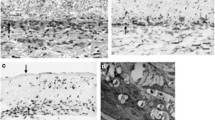Abstract
Polyurethanes are one of the most popular groups of biomaterials applied for medical devices. Their segmented block copolymeric character endows them a wide range of versatility in terms of tailoring their physical properties, blood and tissue compatibility. Polyester- and polyether-urethanes have been modified with hydroxypropyl cellulose aiming the change of their surface and bulk characteristics to confer them biomaterial qualities. In this respect, dynamic contact angle measurements, dynamic mechanical analyses accompanied by mechanical testing have been done. Platelet adhesion test has been carried out in vitro and the use of hydroxypropyl cellulose in the polyurethane matrix reduces the platelet adhesion and therefore recommends them as candidates for biocompatible materials.








Similar content being viewed by others
References
Napper DH. Steric Stabilization of Colloidal Dispersions. New York: Academic Press; 1983.
Vermette P, Griesser HJ. Biomedical Applications of Polyurethanes, Tissue Enginering Intelligence Unit. Texas, USA: Landes Bioscience; 2001.
Gast A, Leibler L. Interactions of sterically stabilized particles suspended in a polymer solution. Macromolecules. 1986;19:686–91.
Adhicari R, Gunatillake PA. Biodegradable synthetic polymers for tissue engineering. Eur Cells Mater. 2003;5:1–16.
Zdrahala IJ, Zdrahala RJ. Biomedical applications of polyurethanes: a review of past promises, present realities and a vibrant future. J Biomater Appl. 1999;14:67–90.
Lelah MD, Cooper SL. Polyurethanes in Medicine. Boca Raton, FL: CR Press; 1999.
Plank H, Syre I, Dauner M, Egberg G, editors. Polyurethane in Biomedical Engineering: II. Progress in Biomedical engineering, 3. Amsterdam: Elsevier Science; 1987.
Cooper S, Lamba NMK, Woodhouse KA. Polyurethanes in Biomedical Applications. New York: CRC Press; 1997.
Yoon S-S, Kim J-H, Kim S-C. Synthesis of biodegradable PU/PEGDA IPNs having micro-separated morphology for enhanced blood compatibility. Polym Bull. 2005;53:339–47.
Hsu S, Kao Y-C. Biocompatibility of poly(carbonate urethane)s with various degrees of nanophase separation. Macromol Biosci. 2005;5:246–53.
Wang L-F, Wei Y-H. Effect of soft segment length on properties of fluorinated polyurethanes. Colloids Surf B: Biointerfaces. 2005;41:249–55.
Yoo H-J, Kim H-D. Characteristics of crosslinked blends of Pellethene and multiblock polyurethanes containing phospholipid. Biomaterials. 2005;26:2877–86.
Hanada T, Li Y-J, Nakaya T. Synthesis and hemocompatibilities of cellulose-containing segmented polyurethanes. Macromol Chem Phys. 2001;202:97–104.
Lelah MD, Lambrecht LK, Young BR, Cooper SL. Physicochemical characterization and in vivo blood tolerability of cast and extruded biomer. J Biomed Mater Res. 1983;17:1–22.
Merril EW, Sa da Costa V, Sulzman EV, Brier-Russell D, Kirchner L, Waugh DF, et al. In: Cooper SL, Peppas NA, editors. Biomaterials: interfacial phenomena and applications. ACS Adv Chem Serv, vol. 199. 1982. p. 95–121.
Abraham GA, de Queiroz AAA, San Roman J. Immobilization of a nonsteroidal antiimflammatory drug onto commercial segmented polyurethane surface to improve haemocompatibility properties. Biomaterials. 2002;23:1625–38.
Nakaya YJ, Zhang Z, Kodama M. Blood compatible phospholipid-containing polyurethane: synthesis, characterization and blood evaluation. J Biomater Appl. 1997;12(2):167–91.
Macocinschi D, Filip D, Vlad S. New polyurethane materials from renewable resources: synthesis and characterization. e-Polymers, no. 062, 1–12 (2008). http://www.e-polymers.org.
Macocinschi D, Filip D, Butnaru M, Dimitriu CD. Surface characterization of biopolyurethanes based on cellulose derivatives. J Mater Sci: Mater Med. 2008;. doi:10.1007/s10856-008-3626-8.
Sirear AK. Elastomers. In: Turi EA, editor. Thermal characterization of polymeric materials, 2nd ed., vol. 1. USA: Academic Press; 1997. p. 970–1025.
Park KD, Okano T, Nojiri C, Kim SW. Heparin immobilization onto segmented polyurethaneurea surfaces-effect of hydrophilic spacers. J Biomed Mater Res. 1998;22:977–92.
Heijkants RGJC, van Calck RV, van Tienen TG, de Groot JH, Buma P, Pennings AJ, et al. Uncatalyzed synthesis, thermal and mechanical properties of polyurethanes based on poly(epsilon-caprolactone) and 1,4-butane diisocyanate with uniform hard segment. Biomaterials. 2005;26:4219–28.
Lligadas G, Ronda JC, Galia M, Cadiz V. Poly(ether urethane) networks from renewable resources as candidate biomaterials: synthesis and characterization. Biomacromolecules. 2007;8(2):686–92.
Mondal S, Hu JL. Structural characterization and mass transfer properties of polyurethane block copolymer: influence of mixed soft segment block and crystal melting temperature. Polym Int. 2006;55:1013–20.
Gao S, Zhang L. Molecular weight effects on properties of polyurethane/nitrokonjac glucomannan semiinterpenetrating polymer networks. Macromolecules. 2001;34:2202–7.
Huang J, Zhang L. Effect of NCO/OH molar ratio on structure and properties of graft-interpenetrating polymer networks from polyurethane and nitrolignin. Polymer. 2002;43:2287–94.
Raschip I.E, Vasile C, Macocinschi D. Compatibility and biocompatibility study of new HPC/PU blends, Polym Int. 2008. doi 10.1002/pi.2468.
Kajiwara K, Ribeiro CAM. Dilute solution properties of randomly branched polymer systems. I. The particle scattering factor. Macromolecules. 1974;7:121–8.
Spathis GD. Polyurethane elastomers studied by the Mooney Rivlin equation for rubbers. J Appl Polym Sci. 1991;43:613–20.
Sekkar V, Bhagawan SS, Prabhakaran N, Rama Rao M, Ninan KN. Polyurethanes based on hydroxyl terminated polybutadiene: modeling of network parameters and correlation with mechanical properties. Polymer. 2000;41:6773–86.
Lupu M, Macocinschi D, Ioanid G, Butnaru M, Ioan S. Surface tension of poly(ester urethane)s and poly(ether urethane)s. Polym Int. 2007;56:389–98.
Yoo H-J, Kim H-D. Properties of crosslinked blends of pellethene and multiblock polyurethane containing poly(ethylene oxide) for biomaterials. J Appl Polym Sci. 2004;91:2348–57.
Wang YX, Robertson JL, Spillman WB Jr, Claus RO. Effects of chemical structure and the surface properties of polymeric biomaterials on their biocompatibility. Pharmaceut Res. 2004;21:1362–73.
Bajpai AK. Blood protein adsorption onto a polymeric biomaterial of polyethylene glycol and poly[(2-hydroxyethyl methacrylate)-co-acrylonitrile] and evaluation of in vitro blood compatibility. Polym Int. 2005;54:304–15.
Korematsu A, Tomita T, Kuriyama S, Hanada T, Sakamoto S, Nakaya T. Synthesis and blood compatibilities of novel segmented polyurethanes grafted phospholipids analogous vinyl monomers and polyfunctional monomers. Acta Polym. 1999;50:363–72.
Acknowledgements
The authors are grateful for the financial support, to Ministry of Education and Research—Exploratory Research Projects, Code: PN-II-ID-PCE-988/2008.
Author information
Authors and Affiliations
Corresponding author
Rights and permissions
About this article
Cite this article
Macocinschi, D., Filip, D., Vlad, S. et al. Segmented biopolyurethanes for medical applications. J Mater Sci: Mater Med 20, 1659–1668 (2009). https://doi.org/10.1007/s10856-009-3731-3
Received:
Accepted:
Published:
Issue Date:
DOI: https://doi.org/10.1007/s10856-009-3731-3




